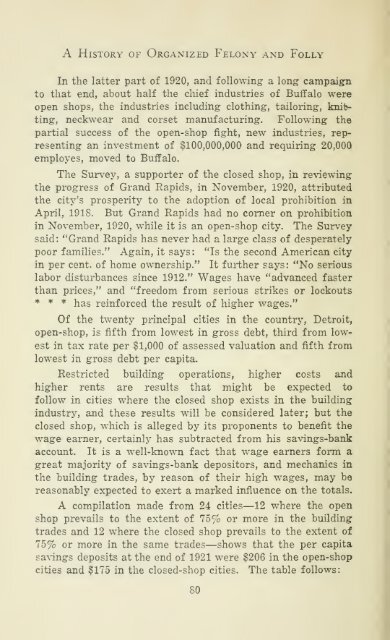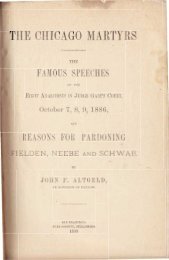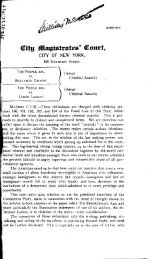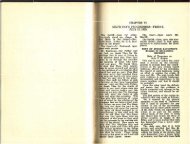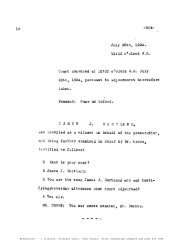A History of Organized Felony and Folly - The Clarence Darrow ...
A History of Organized Felony and Folly - The Clarence Darrow ...
A History of Organized Felony and Folly - The Clarence Darrow ...
Create successful ePaper yourself
Turn your PDF publications into a flip-book with our unique Google optimized e-Paper software.
A <strong>History</strong> <strong>of</strong> <strong>Organized</strong> <strong>Felony</strong> <strong>and</strong> <strong>Folly</strong><br />
In the latter part <strong>of</strong> 1920, <strong>and</strong> following a long campaign<br />
to that end, about half the cliief industries <strong>of</strong> Buffalo were<br />
open shops, the industries including clothing, tailoring, knit-<br />
ting, neclavear <strong>and</strong> corset manufacturing. Following the<br />
partial success <strong>of</strong> the open-shop fight, new industries, rep-<br />
resenting an investment <strong>of</strong> $100,000,000 <strong>and</strong> requiring 20,000<br />
employes, moved to Buffalo.<br />
<strong>The</strong> Survey, a supporter <strong>of</strong> the closed shop, in reviewing<br />
the progress <strong>of</strong> Gr<strong>and</strong> Rapids, in November, 1920, attributed<br />
the city's prosperity to the adoption <strong>of</strong> local prohibition in<br />
April, 1918. But Gr<strong>and</strong> Rapids had no comer on prohibition<br />
in November, 1920, while it is an open-shop city. <strong>The</strong> Survey<br />
said: "Gr<strong>and</strong> Rapids has never had a large class <strong>of</strong> desperately<br />
poor families." Again, it says: "Is the second American city<br />
in per cent, <strong>of</strong> home o\\Tiership." It further says: "No serious<br />
labor disturbances since 1912." Wages have "advanced faster<br />
than prices," <strong>and</strong> "freedom from serious strikes or lockouts<br />
* * * has reinforced the result <strong>of</strong> higher wages."<br />
Of the twenty principal cities in the country, Detroit,<br />
open-shop, is fifth from lowest in gross debt, third from lowest<br />
in tax rate per $1,000 <strong>of</strong> assessed valuation <strong>and</strong> fifth from<br />
lowest in gross debt per capita.<br />
Restricted building operations, higher costs <strong>and</strong><br />
higher rents are results that might be expected to<br />
follow in cities where the closed shop exists in the building<br />
industry, <strong>and</strong> these results will be considered later; but the<br />
closed shop, which is alleged by its proponents to benefit the<br />
wage earner, certainly has subtracted from his sa%dngs-bank<br />
account. It is a well-known fact that w^age earners form a<br />
great majority <strong>of</strong> savings-bank depositors, <strong>and</strong> mechanics in<br />
the building trades, by reason <strong>of</strong> their high wages, may be<br />
reasonably expected to exert a marked influence on the totals.<br />
A compilation made from 24 cities—12 where the open<br />
shop prevails to the extent <strong>of</strong> 75% or more in the building<br />
trades <strong>and</strong> 12 where the closed shop prevails to the extent <strong>of</strong><br />
75% or m.ore in the same trades—shows that the per capita<br />
savings deposits at the end <strong>of</strong> 1921 were $206 in the open-shop<br />
cities <strong>and</strong> $175 in the closed-shop cities. <strong>The</strong> table follows:<br />
80


